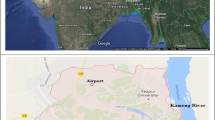Abstract
Spheroidal carbonaceous particles (SCPs) are produced by the high-temperature combustion of fossil fuels and are emitted to the atmosphere. We examined the surface morphology and the chemical composition of SCPs in samples of surface sediment from five industrial cities each of Japan and China, using scanning electron microscopy with energy dispersive spectroscopy (EDS). There exists a relationship between surface morphology and the chemical composition of SCPs in China, but not for SCPs in Japan. The chemical compositions of SCPs differ between Japan and China: those in Japan are S-rich, whereas those in China are Ti-rich. The results suggest that EDS can be used to identify China-derived SCPs in East Asian countries such as Japan, South Korea, and Taiwan.



Similar content being viewed by others
References
Alliksaar, T., Hörstedt, P., & Renberg, I. (1998). Characteristic fly-ash particles from oil-shale combustion found in lake sediments. Water, Air, and Soil Pollution, 104, 149–160.
Cao, Dz, Selic, E., & Herbell, J. D. (2008). Utilization of fly ash from coal-fired power plants in China. Journal of Zhejiang University Science A, 9, 681–687.
Ganor, E., Altshuller, S., Foner, H. A., Brenner, S., & Gabbay, J. (1988). Vanadium and nickel in dustfall as indicators of power plant pollution. Water, Air, and Soil Pollution, 43, 241–252.
Griffin, J. J., & Goldberg, E. D. (1979). Morphologies and origin of elemental carbon in the environment. Science, 206, 563–565.
Griffin, J. J., & Goldberg, E. D. (1981). Sphericity as a characteristic of solids from fossil fuel burning in a Lake Michigan sediment. Geochimica et Cosmochimica Acta, 45, 763–769.
Hirakawa, E., Murakami-Kitase, A., Okudaira, T., Inoue, J., Yamazaki, H., & Yoshikawa, S. (2011). The spatial and temporal distributions of spheroidal carbonaceous particles from sediment core samples from industrial cities in Japan and China. Environmental Earth Science, 64, 833–840.
Kusamichi, H., Iseki, J., Moriya, A., Kanai, A., Nishimura, T., Kanayama, H., & Kusamichi, T. (1996). Titanium industry in Japan and the new technology (p. 196). Tokyo: Agune Gijyutu Center.
Larsen, J. (2003). Size distribution and concentration of spheroidal carbonaceous fly-ash particles (SCPs) in lake sediments as an aid to detecting locally deposited atmospheric pollution. Water, Air, and Soil Pollution, 149, 163–175.
Ma, C. J., Kim, J. H., Kim, K. H., Tohno, S., & Kasahara, M. (2010). Specification of chemical properties of feed coal and bottom ash collected at a coal-fired power plant. Asian Journal of Atmospheric Environment., 4–2, 80–88.
Miller, C. A., & Linak, W. P. (2002). Primary particles generated by the combustion of heavy fuel oil and coal. National Risk Management Research Laboratory, Research Triangle Park, 50pp.
Murakami-Kitase, A., Okudaira, T., & Inoue, J. (2010). Relationship between surface morphology and chemical composition of spheroidal carbonaceous particles within sediment core samples recovered from Osaka Bay Japan. Environmental Earth Science, 59, 1723–1729.
Rose, N. L. (1995). The carbonaceous particle record in lake sediments from the Arctic and other remote areas of the northern hemisohere. Science of the Total Environment, 160(161), 487–496.
Rose, N. L. (2001). Fly-ash particles tracking environmental change using lake sediments physical and geochemical methods (pp. 319–349). Dordrecht: Kluwer Academic.
Rose, N. L., Juggins, S., & Battarbee, R. W. (1994). Fuel type characterization of spheroidal carbonaceous particles using surface chemistry. Ambio, 23, 296–299.
Rose, N. L., Juggins, S., & Watt, J. (1996). Fuel-type characterization of carbonaceous fly-ash particles using EDS-derived surface chemistries and its application to particles extracted from lake sediments. Proceedings of the Royal Society of London. Series A, 452, 881–907.
Rose, N. L., Juggins, S., & Watt, J. (1999). The characterisation of carbonaceous fly-ash particles from major European fossil-fuel types and applications to environmental samples. Atmospheric Environment, 33, 2699–2713.
Acknowledgments
We are grateful to Muneki Mitamura and Eri Hirakawa for their invaluable comments and advice and to Hideo Yamazaki, Kazuo Kamura, and Xiao Jule for providing samples of surface sediment. Jack T. Trevors is thanked for his editorial handling of the manuscript. This work was supported in part by Grants-in-Aid for Scientific Research from the Ministry of Education, Culture, Sports, Science and Technology of Japan (no. 16340157 to S Yoshikawa, no. 07 J10902 to A Murakami).
Author information
Authors and Affiliations
Corresponding author
Rights and permissions
About this article
Cite this article
Momose, A., Inoue, J., Murakami-Kitase, A. et al. Characteristic Differences in the Chemical Composition of Spheroidal Carbonaceous Particles in Japanese and Chinese Cities. Water Air Soil Pollut 223, 4761–4767 (2012). https://doi.org/10.1007/s11270-012-1232-3
Received:
Accepted:
Published:
Issue Date:
DOI: https://doi.org/10.1007/s11270-012-1232-3




